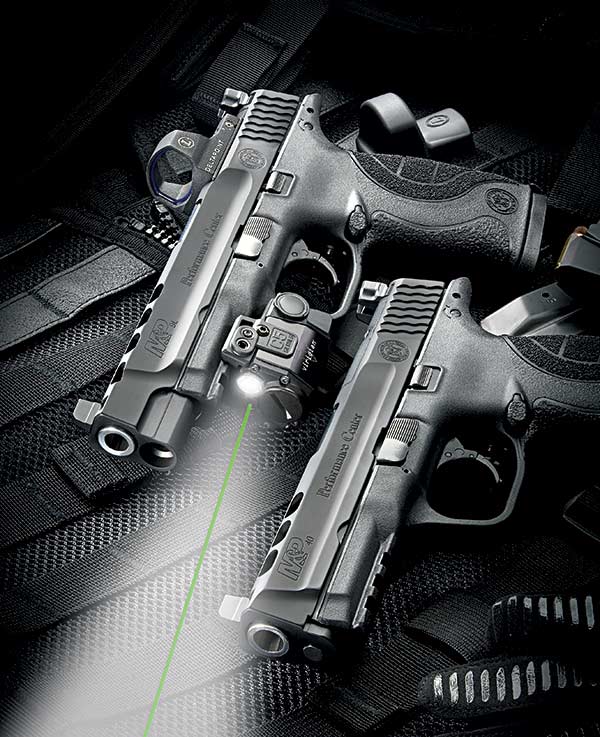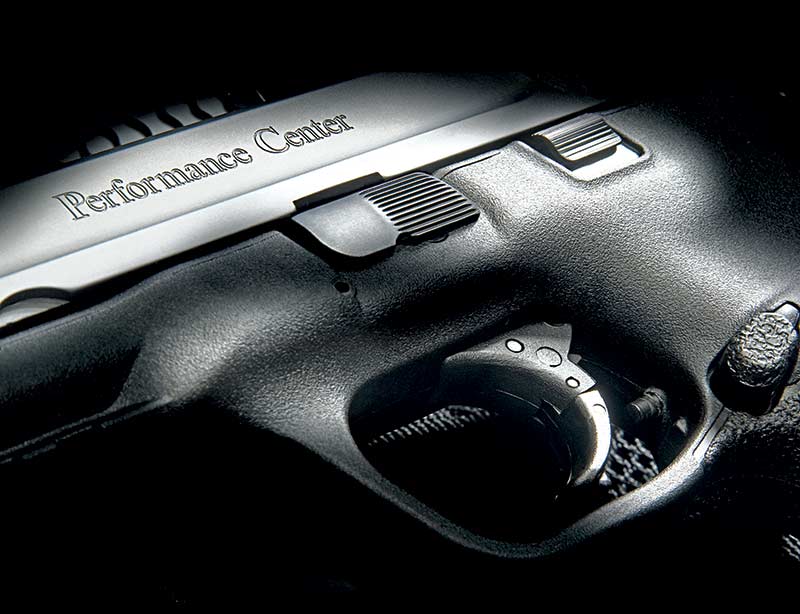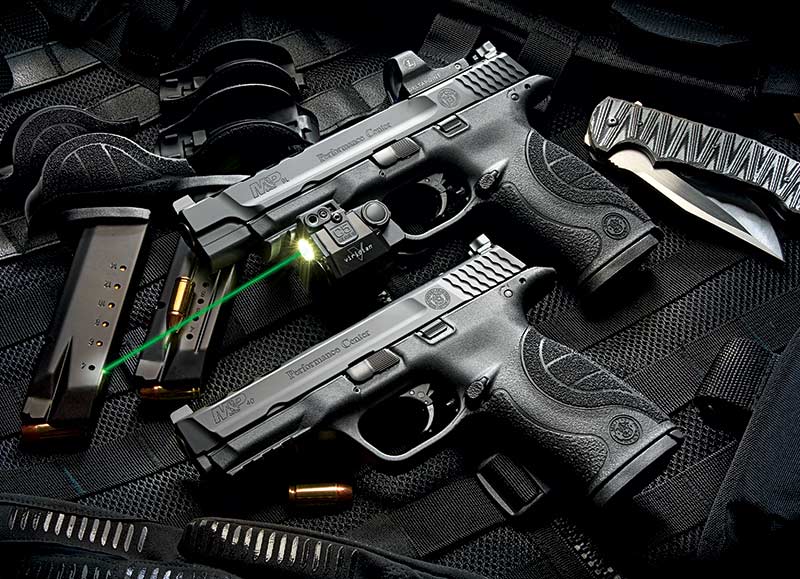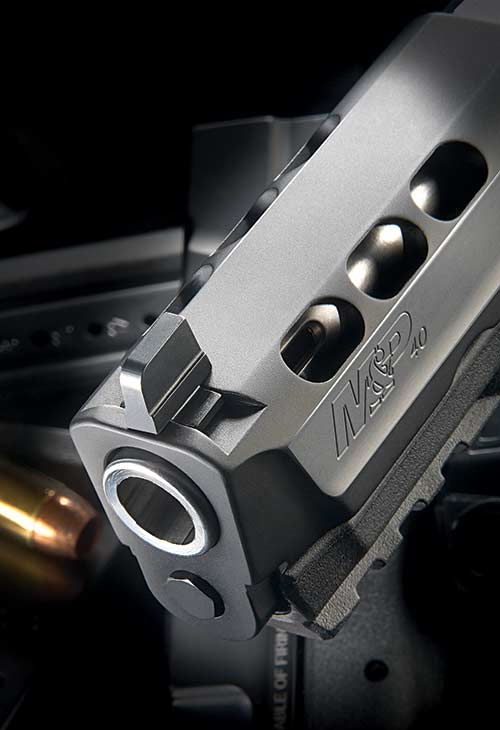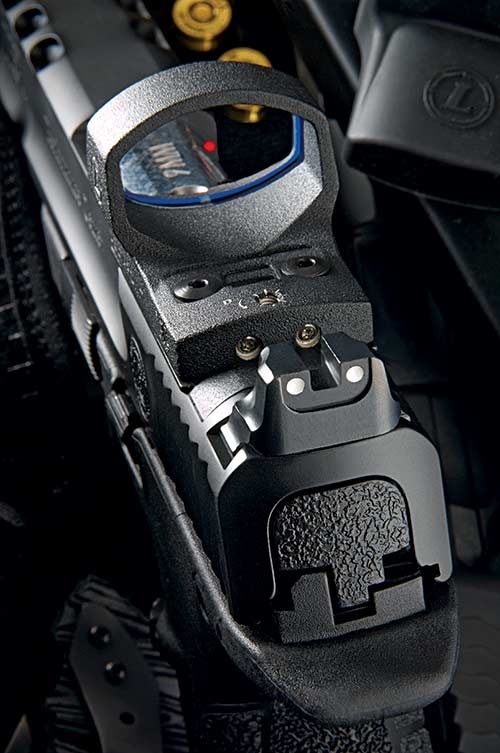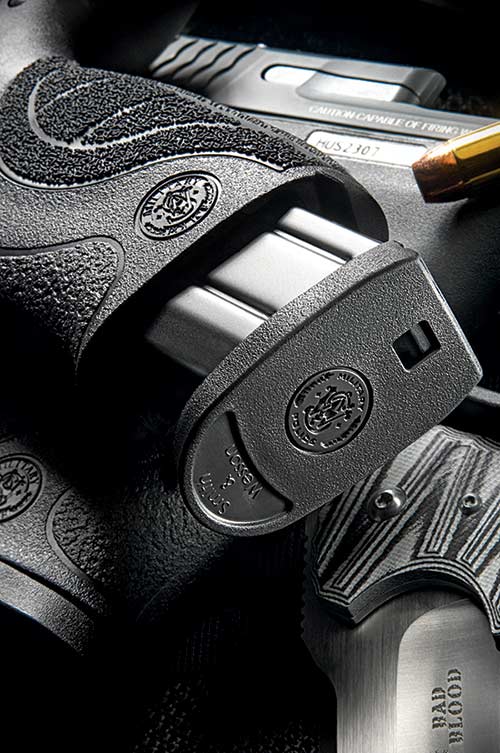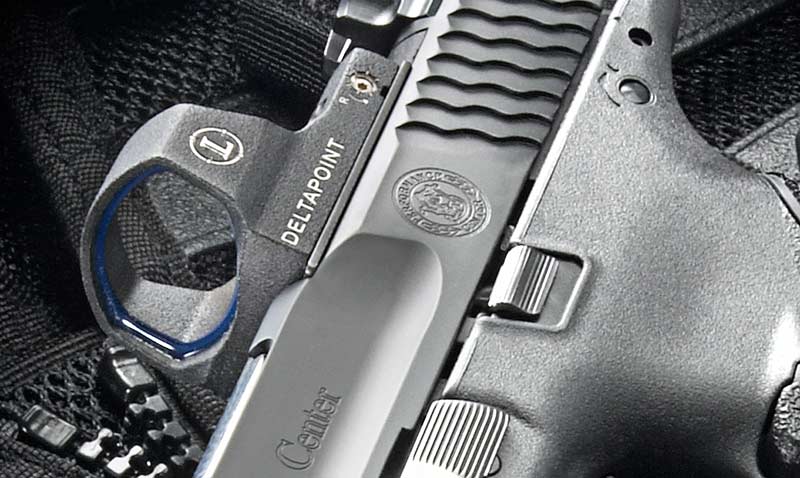S&W’s M&P C.O.R.E. Pistols
Fast, Fun, Flat-Shooting And Optics-Ready!
A golden moment in the Fast Glass & Smokin’ Brass saga: It’s Day Two shootin’ the new ported M&P C.O.R.E. pistols. I’m poppin’ pills into paper with increasing speed and confidence when BH arrives. Good guy; one of the best natural shots I’ve known. He recently slid up hard against 60, and his formerly eagle eyes have finally gone wonky. Like us seasoned mortals he now has that vision disorder called presbyopia, or “Pick One Outta Three,” meaning you’ve got three planes to focus on — rear sight, front sight and target — but now, you can only get a focus on one at a time, and maybe that one’s kinda fuzzy too.
In his 50-plus years of shooting handguns and long guns, including national-level competition, he had used only iron sights and conventional riflescopes; never a red dot, no zero-magnification glass at all. They just hadn’t interested him. He had heard scraps of scuttlebutt about reflex sights relieving that “Pick One” problem, and I invited him to try ’em out. Gave him a mini-brief on the optic, handed him the long-slide Nine, and I went back to work with the Forty.
I heard irregular, desultory shots and looked over. BH was makin’ molasses look zippy; dawdling over shots, holding position way too long, seemingly intent but frustrated, blowin’ steam out his ears. I asked, Wassup, Doc? He ’splained.
It was drivin’ him nuts trying to get that triangly-thing (the Leupold DeltaPoint reticle) oriented exactly dead-center horizontally and vertically on the screen, and beyond that he was also tryin’ to perch the reticle dead-bang on top of the front iron sight, and properly centered in the rear sight’s U-notch. Plus, he snorted, that reticle jittered! He just couldn’t get it dead-still. “This is stupid,” he concluded. So I ’splained.
’Splained
“First,” I says, “Don’t wait for the reticle to be frozen in space. It ain’t gonna happen. That delta is 7.5-MOA, but ask yourself how much it covers at handgun range, like 10, 15, 20 yards? How much does a handgun front-sight blade cover at 100 yards? Teensy reticle jitters don’t mean squat.” Hmm, he hummed.
To illustrate the rest, I put up a fresh target with a 1.25″ black center, then target-taped over the iron sights and told him to ignore them. Then I had him concentrate only on layin’ the screen-centered reticle on the dot and squeezin’. Next, I told him to move the reticle-overlaid dot up toward 12 o’clock on the screen and shoot. We repeated this with the reticle-covered dot at 3, 6 and 9 o’clock, then approached the target. Of course, there was a tight little 5-round group. He looked at the DeltaPoint as though it had turned into a baby dragon. His eyes goggled.
“Art thou a wizard, sir knight?” he demanded. “What sorcery is this?” (He talks like that sometimes.)
“Nay, my liege,” quoth I (I go along with it). “Ain’t no sorcery. It’s some enchanted glass, though. Think of it as a floptical delusion, like an optical illusion but real. Once zeroed, you just lay that reticle where you want the slug to splot. Now go forth and conquer. Work that sweet reset. And on these ported jobs, you’ll find the muzzle agreeably tamed.”
Minutes later he was cuttin’ clover-groups and chuckling. Thirty minutes after that he was hammerin’ like a belt-fed 1919 Browning machinegun, tearin’ out target centers and laughing. Ten minutes later he was shootin’ circles around me and politely hiding a smirk. Thus ended the intro to handgun optics, and acquaintance with the pleasures of a ported C.O.R.E. pistol.
Your results may vary. My results varied. I recommend three days, three structured sessions, minimum: Familiarization, Skill-Building then Speed-Work. He did it in one short session, but … The guy’s a wizard. Really. Now, back to our regular programming.
Evolution, Revolution, Etc.
I won’t go into a lot of the mech-and-tech specs of the M&P pistols, because a ton of ink has already been spilled on ’em. Relatively light, polymer-framed, strong, tough, rock-solid reliable and commendably accurate outta the box, they’re very reasonably priced for the quality. When you consider they’ve only been around for a bit over a decade, they’ve made a heck of a footprint compared to any competitor. With features including multiple frame sizes and calibers, ambidextrous slide locks, side-swapping mag releases, three grip insert sizes, options in finishes, thumb safeties or slick-sides, smooth or threaded barrels, lasers and more, it’s a smorgasbord of shootin’ sweetness, as many of you have already discovered.
Quickly following their debut, the modern iteration of Military & Police pistols tore off huge chunks of the law enforcement market, with massive consumer sales following in that wide wake. It’s a mark of having made your bones in the crucible when large numbers of competitive shooters adopt your service pistols.
Soon they began buggin’ Smith & Wesson for more refinements. The Pro Series offered 5″ “long slide” models in addition to 4.25” standards, and an additional kiss-an’-tickle from the Performance Center in the forms of slicked-up cycling and smoothed-out triggers. But they wanted more.
With the C.O.R.E. — Competition Optics Ready Equipment — models, M&P shooters in the action sports got pistols with slides already machined for fast glass, supplied with an array of adaptor plates to go under a contour-fitted, unobtrusive cap just forward of the rear sight. The Leupold DeltaPoint, which we tested, plus the Trijicon RMR, JPoint, Docter Red Dot, C-More STS and Insight MRDS are all accommodated.
A note: given a suggested retail price differential of only $80 between, for example, the Pro Series 5″ 9mm pistol and its C.O.R.E. cousin, the optics-ready model is a sweet deal. You get about $250-$300 worth of machining and adaptor plates, and when you don’t want an optic riding on it, you’ve got a smooth-topped “regular” Pro Series with taller, bolder iron sights, which sit higher to co-witness with most optics — and also will clear many suppressors.
Another added improvement was a new texture for the interchangeable backstraps. They’re so perfectly grippy and stick-to-the-hand, owners of pre-C.O.R.E. Pro Series M&P’s — like my son — have purchased the new backstraps and slapped ’em on their veteran M&P’s. I wouldn’t waste the words on it if they weren’t that good, folks.
Now, for you Open Division, Wizard-Class action shooters irritated with that pesky “muzzle flip” phenomenon, ported and compensated M&P C.O.R.E. pistols are rollin’ out of the Performance Center. On the 5″ long-slides, there are four oblong ports on each side of the slide measuring about .40″ long by .2″, and two slots cut in the barrel at about 10 and 2 o’clock, placed .72″ to the rear of the muzzle. Our test sample 4.25″ barreled .40 S&W C.O.R.E. had three ports per side and two compensator slots in its barrel of similar but slightly differing dimensions — and you can bet those dimensions are no whim or accidents. The slide ports are all about lightening the slide for faster cycling while the barrel cuts are tasked with the compensating, but both effects are the result of extensive testing and computer modeling for top performance.
That’s not all that’s different though. The ported C.O.R.E.’s also feature a new adjustable trigger over-travel stop, and a new trigger sear yielding a smoother pull, a cleaner break and faster re-set, all for about $43 more than their un-ported cousins. How’s that?
Ducks In A Row
Don’t ya just love it when all your ducks line right up in a neat row? Sandwiched between vicious sleet storms, we had three days of fair skies and light winds for some great range time. Our two test pistols were a ported C.O.R.E. 4.25″ barrel .40 S&W (15-1 capacity) and a ported C.O.R.E. 5″ 9mm (17+1). They both checked out terrific; smooth cycling, all systems running nominal, mags locking up tight and dropping free. The 9mm’s trigger gauged at a smooth 5 pounds 6 ounces and the .40’s trigger pull measured 5 pounds 14 ounces. Takeup was short and sweet, the break was clean on both pistols, over-travel was virtually zip, and reset was very short and easy to work. The Leupold DeltaPoint optic was a breeze to install.
We had good ammo for testing. For the Nine, some Hornady Steel Match HAP in 115-gr. and 125-gr. weights, and lots of “white box” Winchester 147-gr. FMJ Target loads. Feed for the Forty was Cor-Bon 160-gr. FMJ’s, Nosler Match Grade 150-gr. JHP’s, and Federal Premium Personal Defense 165-gr. Hydra-Shok; great stuff. What more could we ask? This:
We managed to borrow two un-ported, non-compensated C.O.R.E. pistols to match our ported C.O.R.E.’s. Yup; a long-slide Nine, a standard-length Forty — and a twin to our sample DeltaPoint! Now we could shoot both flavors side by side to test the effects of the enhancements.
We shot the ported long Nine first. Frankly, I thought, “Nice shooter, but can I really tell any difference in muzzle behavior? Huh.” Then I shot the un-ported Nine and immediately switched back to the ported C.O.R.E.; repeat-repeat-repeat. Okay, then I could tell. The action’s got a tad more zip and muzzle flip is reduced. Cool. Then we went through the same process with the Forty — and whoa. The effect was such that you wanta call strangers over and say, Dude, you gotta try this! Then you come to your senses and hog it all to yourself.
Had to settle down and run accuracy tests; almost a waste of time. At 15 yards, 2-handed, we shot 5-round groups cadenced (about one shot per 1.0 to 1.5 seconds) with groups running 11/2″ to 13/4″. Boring. Pushed it back to 25 yards and shot rested, two-handed. How’s 1.87″ to 2″ grab ya? Other than learning the Nine didn’t care much for the HAP 115’s but loved the 125’s, there were no surprises. But inherent accuracy is the sideshow in this carnival; necessary but secondary. Fast, rapid-fire doubles, triples, speed-shifting from target to target and hammering full magazine loads is where the ported C.O.R.E.’s come to life!
I’ve got more words than space allows, but check this: With the Nine at 7 yards, rapid fire — like mas rapido! — 17 rounds, 16 of ’em within 13/4″ high by 1.37″, with 15 shots touching. With the Forty at 10 yards, rapid fire, 15 rounds into 1.75″ by 1.875″, with 14 touching. You get the drift. I’ll take a little credit; I was having an excellent day, but … all those other ducks, y’know?
Leupold’s DeltaPoint Reflex Sight
Fast, Enchanted Glass
How do you pack a ton of quality, technology and toughness into a teensy package weighing six tenths of an ounce? I dunno, but Leupold did it in their DeltaPoint Reflex Sight. Physically, it’s more rugged than it looks, with a hard-coated magnesium case, DiamondCoat protection on its wide-screen 1.02″ by .75″ lens, and it’s completely waterproof. Functionally, it features a full 60 MOA elevation adjustment range matched by 60-MOA of windage, a distinctive 7.5-MOA delta-shaped (a triangle, like the upper-case Greek letter “delta”) reticle that’s easy to focus on. Many users find it far easier to track with the eye than a typical round red dot.
The techno-juju is pretty stunning. Intelligent Brightness Control (IBC) automatically adjusts the brightness of the red delta reticle, not just according to the ambient light, but “forward-looking,” so it’s assessing the light specifically in the direction of your target! Other magic turns it on, turns it off after five minutes without movement, then flashes it back to life instantly when put into play. Slip the rubber cover over it, and it goes to sleep at minimum power, to awaken instantly when the hood is removed. As you move from bright light into darkness and back again, the reticle brightness adjusts at the rate of the dilation of your pupils, so your eyes aren’t lagging or playing catch-up.
There are ten different mounting bases available for a wide range of weapons, and a cross-slot base allowing mounting to any rail system. The sight can leap from handguns to carbines to shotguns to submachineguns and back again.
Otherwise, it offers the same old boring Leupold qualities, like crystal clarity, superb light transmission, easy maintenance, a full lifetime guarantee … Yawn …
The DeltaPoint Reflex Sight lists for $564 in the “all mounts” kit, and is also available with a 3.5-MOA round dot version. It’s truly a case of “You get what you pay for” — in this case, quality.

